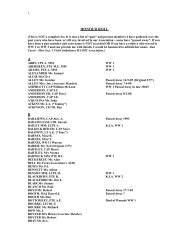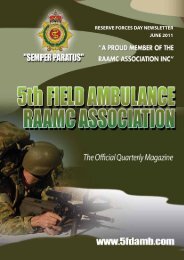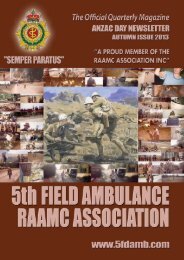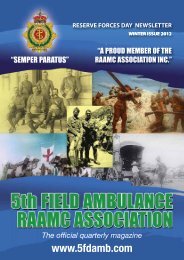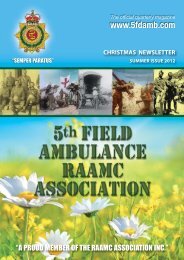2010 Paulatim Magazine - RAAMC Association
2010 Paulatim Magazine - RAAMC Association
2010 Paulatim Magazine - RAAMC Association
You also want an ePaper? Increase the reach of your titles
YUMPU automatically turns print PDFs into web optimized ePapers that Google loves.
inversion and knee strains. A quick recovery is needed to enable the<br />
member to resume his role in the best possible physical condition.<br />
Adapted treatment regimes are often applied, extending the normal<br />
treatment into the field for the situation they are going into.<br />
An example of this is a Costovertebral joint strain, where the member<br />
continues the correction OTW by using a rolled up towel, cat stretches or<br />
a tennis ball under the joint. Lumbar facet joint dysfunction is another<br />
example that was often seen because of the weight carried OTW. This<br />
dysfunction was usually successfully treated quickly with a localised<br />
Lumbar manipulation, with a follow up program.<br />
The mind set of SOTG members is also of consideration in their<br />
rehabilitation. They are highly motivated and focused individuals which<br />
can be used to a physiotherapistís advantage in their rehabilitation by<br />
facilitating and accelerating their recovery. Due to their high fitness<br />
level, recovery can be fast tracked but this can be off set by the<br />
physical demands placed on the body when performing their assigned<br />
tasks OTW. Having such a close invested hands on application to their<br />
injury; the physiotherapist is in the best position to offer careful<br />
guidance to the patient (and to their superior) in what they can and<br />
canít do OTW in terms of their injury, as not to aggravate or to put at<br />
risk their recovery rate.<br />
The weight from body armour, ammunition, weapon, helmet and back<br />
pack whilst on extended patrols or riding inside a Bush Master (BM)<br />
vehicle, was found to contribute to spinal joint dysfunctions.<br />
Manipulation to these joints, muscular dry needling, specific mobilising<br />
stretches and strengthening programs facilitate a quick and effective<br />
recovery. Occasionally taping was also used to maintain correction and<br />
to de-load the injury site. One example of a potentially serious<br />
condition experienced by a SOTG member was constant bilateral pins<br />
and needles extending down the arms from C7 and 8 nerve roots. This<br />
problem had the potential to return the member to Australia for long<br />
term treatment, thereby depleting the unit of a valuable operator and<br />
effectively reducing the effectiveness of his section as their was no<br />
replacement and also adding a monetary cost for the ADF. This member<br />
was able to remain in country with his section whilst undergoing<br />
mobilisation treatment (grade III unilateral PAís) to his lower neck<br />
region, together with neural glides, and was able operate normally OTW<br />
with some careful guidance in regards to specific exercises and postural<br />
advice. He made a full recovery prior to the end of his rotation.<br />
Lower leg muscular-skeletal injuries pose a serious challenge for the<br />
physiotherapist because of the need for the member to be able to jump,<br />
run, squat and land from various heights (e.g. inserting from a<br />
helicopter, jumping down from a B M vehicle or running over rough<br />
ground whilst under fire). The physiotherapist carefully balances the<br />
restoration of movement, with strength and stability and the reduction<br />
of pain. One particular example was an ankle inversion sprain in which<br />
the SOTG member was rehabilitated from an inability to weight bear<br />
due to pain, weakness and swelling through, not only to full function<br />
Grade III unilateral mobilisation to C7/T1 to restore segmental mobility<br />
for the nerve root to exit.<br />
but to a function that demanded the ankle to perform beyond normal<br />
expected requirements. Again, he was able to stay with his unit and be<br />
a valuable participant in their operations while undergoing his<br />
rehabilitation.<br />
Another aspect of this deployment was the concept of Hearts and Minds.<br />
I provided a physiotherapy service once a week to US FST Camp Ripley,<br />
treating local Afghan civilians who had been injured either through<br />
accident or conflict. This contributed to their overall perception that we<br />
were the preferred help rather than the Taliban. There were many<br />
orthopaedic conditions, the majority being fractures as a result of gun<br />
shot wounds. One example was an elderly Afghan man who had been<br />
shot in the thigh, fracturing his Femur. Not only was there a need to<br />
keep his upper and lower limbs functional but also a requirement for a<br />
walking frame, which I fashioned out of two unserviceable metal chairs<br />
for him to mobilise with. This allowed him to return home using the<br />
walking frame and freed up a valuable bed space which was much<br />
needed in the FST. Treating many of these hypo-mobile ankles and<br />
knees following removal of the external fixation and rehabilitating<br />
them back to functional walking again, harked back to those earlier<br />
days of physiotherapists in WW1.<br />
The experience of front line physiotherapy taught me the need to draw<br />
upon all my years as a physiotherapist to deal with complex clinical<br />
issues that were posed in a unique but demanding environment, and to<br />
often think laterally to overcome clinical problems or deficiencies.<br />
PAULATIM<br />
PA U L AT I M – M A GAZINE O F T HE R OYA L A U S T R A L I A N A R M Y M E DICAL C O R P S – 2 0 1 0 9 1



